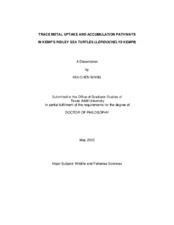| dc.description.abstract | Little is known of trace metal concentrations and their possible role in the
mortality of critically endangered Kemp??s ridley sea turtles (Lepidochelys kempii).
Research described herein characterized concentrations of seven trace metals ??
Ag, Cd, Cr, Cu, Hg, Pb and Zn ?? in the blood and carapace tissue of captive
Kemp??s ridleys for use in assessing levels of these metals in wild counterparts.
Concentrations of same trace metals were characterized in post-pelagic through
adult life stages of 127 wild Kemp??s ridleys captured from the Gulf of Mexico and
southeast Atlantic during 2000 to 2002. Blood, carapace, liver, kidney, and
muscle tissues from live and/or stranded Kemp??s ridleys were analyzed for the
aforementioned trace metals via graphite furnace atomic absorption
spectrophotometer and cold vapor atomic fluorescence techniques conducted
under class-100 clean laboratory conditions. Similar trace metal assessments
were conducted on blue crab (Callinectes sapidus) prey to determine the role of
food as a possible uptake pathway in Kemp??s ridleys.
Overall, trace metal levels in live, captive as well as wild ridleys were higher
in carapace tissue than in blood. Carapace concentrations of Ag, Cr and Hg in
Kemp??s ridleys across all post-pelagic life stages increased with increasing
straight carapace length (SCL). Carapace tissue of wild ridleys exhibited higher
Cr, Hg, and Pb levels than their blue crab prey, regardless of study area;
whereas, crabs yielded higher Ag and Cu concentrations. Dead stranded ridleys
yielded higher Ag, Cr, Hg, Pb, Zn levels in carapace tissue, whereas, their liver
exhibited higher Cd and Cu levels. This finding suggests carapace tissue could
serve as a suitable surrogate sample source for internal organs/tissues when
monitoring exposure of live Kemp??s ridleys to certain metals. The fact that larger,
stranded ridleys exhibited higher Ag, Cd, Hg, Pb and Zn levels than did their
smaller, live analogs from Texas and Louisiana implies that these older ridleys
had increased opportunities to accumulate higher metal concentrations in their
carapace tissue than did their younger conspecifics. This trend suggests that
carapace tissue has the potential to accumulate trace metals while blood-borne
concentrations reflect only recent exposure to trace metals. | en |


